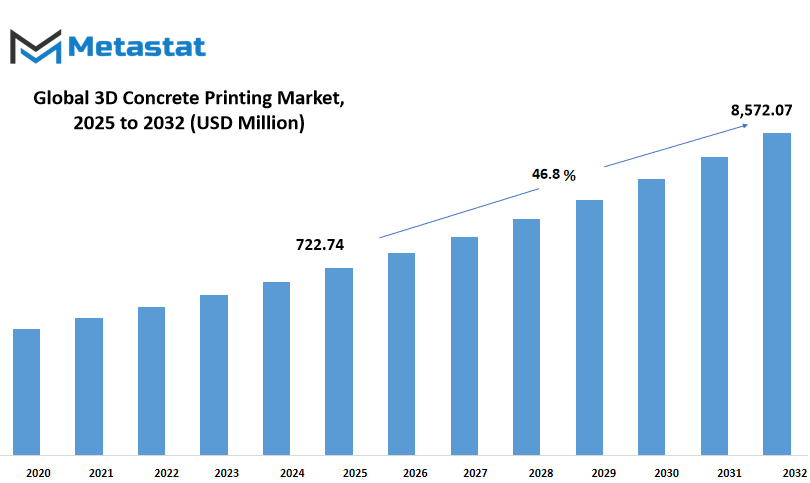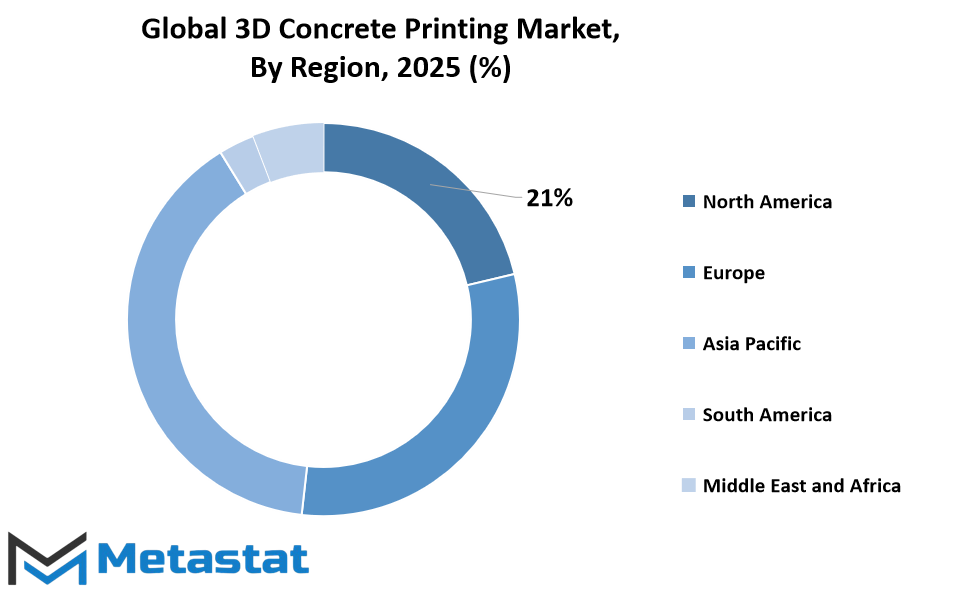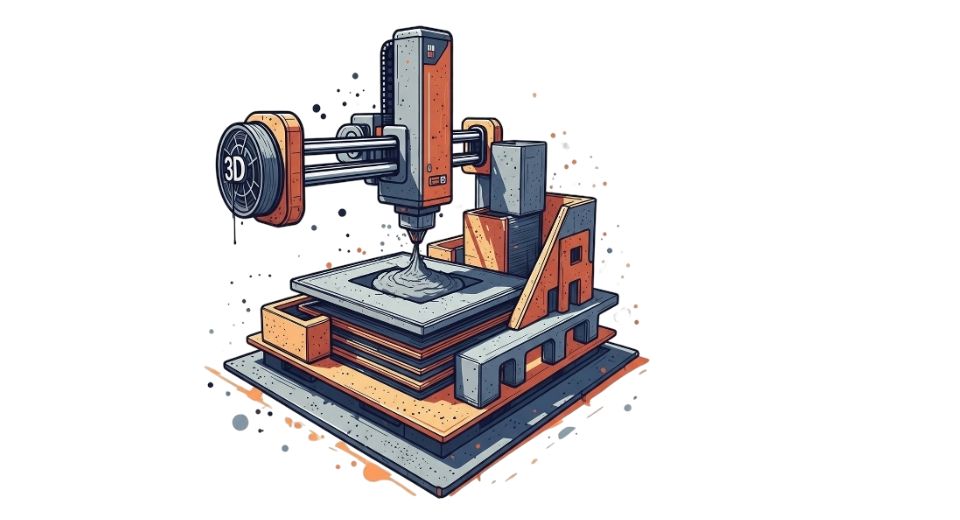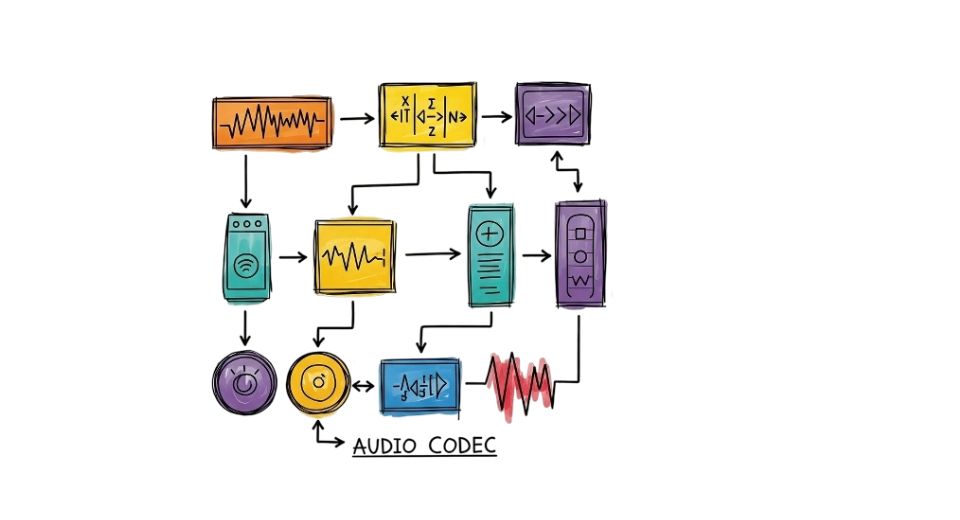MARKET OVERVIEW
The global 3D concrete printing market can expect to experience steady growth in the upcoming period due to a series of key reasons favoring its expansion. Among the primary reasons for this expansion is the increasing demand for faster and less expensive methods of construction. Traditional methods of building typically cost around more time, labor, and material, while 3D concrete printing provides a solution that can reduce all of them at the same time. With the capability to create complex structures and shapes in an instant, this technology is now gaining popularity among builders and developers who are constantly looking for ways to save both time and resources without sacrificing quality.
The other force that will drive the global 3D concrete printing market is growing focus on sustainable building practices. The world is becoming more focused on reducing waste, carbon emissions, and wasting less resources. 3D concrete printing is amenable to these goals as it produces little construction waste, has lower material needs, and is likely to deliver more energy-efficient buildings. While sustainability is the driver for decisions in the construction industry, more and more companies will turn to employing this technology.
But there also are challenges ahead for it that might impede the development of the global 3D concrete printing market. One is the lack of experts with a complete understanding of this relatively new technology. Without enough people qualified to operate and take care of such sophisticated machines, it would be difficult for the market to develop as quickly as expected. Moreover, there are still nations lacking visible regulations or standards on 3D printed homes, which would cause delays and hesitation among developers and investors.
On the positive side, new advances in materials and technology would bring profitable prospects to the global 3D concrete printing market. With scientists creating stronger, more resilient, and elastic materials that could be employed in 3D concrete printing, the scope of applications would be broader. These could be from affordable housing development to specialty architectural structures that could not be achieved through traditional methods. Also, as the globe witnesses more viable examples of 3D printed buildings come into view, it becomes more probable that trust in the technology will grow, encouraging more investment. In the coming few years, the convergence of greater building velocity, reducing costs, and demand for sustainability will drive the global 3D concrete printing market, opening up new avenues for the building and infrastructure of buildings.
Global 3D concrete printing market is estimated to reach $8,572.07 Million by 2032; growing at a CAGR of 46.8% from 2025 to 2032.

GROWTH FACTORS
The global 3D concrete printing market is expected to witness steady progress in the future due to several important factors that support its growth. One of the most significant reasons behind this growth is the increasing demand for faster and more cost-effective construction methods. Traditional construction techniques often require more time, manual labor, and resources, while 3D concrete printing offers a solution that can reduce all of these at once. With the ability to create complex shapes and structures quickly, this technology is becoming more attractive to builders and developers who are constantly looking for ways to save both time and money without compromising on quality.
Another factor that will help push the global 3D concrete printing market forward is the rising focus on sustainable construction practices. The world is becoming more aware of the need to reduce waste, lower carbon footprints, and make better use of resources. 3D concrete printing supports these goals because it produces less construction waste, requires fewer materials, and often leads to more energy-efficient buildings. As sustainability continues to influence choices in the construction industry, more companies are likely to turn to this technology.
However, there are also some challenges that might slow down the progress of the global 3D concrete printing market. One of these is the lack of skilled professionals who fully understand this relatively new technology. Without enough people trained to operate and maintain these advanced machines, it could be difficult for the market to expand as quickly as expected. In addition, some countries still do not have clear regulations or standards for 3D printed buildings, which could create delays and hesitation among builders and investors.
On the positive side, future advancements in materials and technology would provide lucrative opportunities for the global 3D concrete printing market. As researchers continue to improve the strength, durability, and flexibility of the materials used in 3D concrete printing, the range of possible applications will grow. This could include everything from affordable housing projects to unique architectural designs that would not be possible using traditional methods. Moreover, as more successful examples of 3D printed buildings appear around the world, confidence in this technology is likely to grow, encouraging further investment.
In the coming years, the combination of faster building methods, cost savings, and the push for sustainability will continue to drive the global 3D concrete printing market, opening up new possibilities for how buildings and infrastructure are created.
MARKET SEGMENTATION
By Printing System
The global 3D concrete printing market is gaining attention as a technology that could change how buildings and infrastructure are created in the future. This method of construction is not only fast but also offers flexibility in design that traditional methods cannot achieve. It is already being used for projects such as houses, bridges, and even schools, showing that this technology is more than just an idea; it is becoming a practical solution. As this market grows, it is divided by the type of printing systems being used. These include Gantry-based Systems, Robotic Arm-based Systems, and Crane-based or Contour Crafting Systems. Each of these systems brings unique strengths to the table, helping companies achieve specific project goals with greater precision.
The value of these segments shows how much investment and interest there is in this field. Gantry-based Systems are valued at USD 417.65 million, Robotic Arm-based Systems at USD 236.22 million, and Crane-based or Contour Crafting Systems at USD 68.86 million. These figures point to the clear confidence businesses and developers have in the potential of these technologies. Looking ahead, the global 3D concrete printing market will likely see further advancements that make these systems even more efficient and affordable. As more companies and governments aim for greener and faster construction solutions, this market will be seen as a key part of meeting those demands.
In the future, people will likely witness entire neighborhoods or industrial zones being built using these 3D printing systems. The speed at which buildings can be constructed will improve, reducing the time needed from months to weeks or even days. This will not only save time but also lower labor costs and reduce waste, making construction more sustainable. These benefits will drive more adoption across both developed and developing countries, where there is always a need for quicker and more affordable housing solutions.
Moreover, architects and engineers will continue to push the boundaries of design, creating structures that would have been impossible or too expensive with traditional methods. The global 3D concrete printing market will play a major role in shaping future cities, offering solutions that meet both environmental and economic needs. As this technology improves, it will become more accessible to smaller companies, not just large corporations, which will help spread its benefits across various industries and regions. This progress suggests a future where construction is smarter, faster, and more flexible than ever before.
By Material Type
The global 3D concrete printing market is expected to see steady growth as technology continues to influence the construction industry. This technology brings a new approach to building structures, helping to make construction faster, more efficient, and less wasteful. In the future, this method will likely become more common across residential, commercial, and infrastructure projects. One key reason is the growing demand for sustainable construction solutions. 3D concrete printing helps reduce material waste and can use recycled materials, which makes it more appealing in a world that will continue to focus on environmental responsibility.
Looking at the materials used within this market, there are several types expected to play important roles moving forward. Cement-based concrete mixes are currently the most popular and will likely keep their strong position because of their familiarity and availability. These mixes are easy to adapt to 3D printing technology, making them a solid choice for many types of projects. However, as technology moves forward, other materials are expected to become more common.
Geopolymer-based mixes are gaining attention because they offer benefits like lower carbon emissions compared to traditional cement. In the future, as governments and companies continue to look for greener solutions, these mixes will likely see more demand. Fiber-reinforced concrete mixes will also remain important because they add strength and durability to printed structures. This will be especially useful in areas where buildings must withstand harsh conditions or heavy use. These materials help make sure that the printed structures are not only creative but also safe and long-lasting.
Custom proprietary mortars and binders are another area expected to see growth. Companies are working on creating special blends that are designed specifically for 3D printing applications. These custom materials can help improve the speed and quality of printed structures, offering solutions tailored to unique projects. As companies look for ways to stand out in the global 3D concrete printing market, these custom materials will play a bigger role.
Looking ahead, this market will continue to evolve as technology advances and more companies explore what 3D printing can do for construction. New materials and improved techniques will shape the future, leading to more efficient, creative, and sustainable building methods. While there are still challenges to overcome, such as regulations and large-scale adoption, the potential is clear. The global 3D concrete printing market will likely become a key part of modern construction in the years to come.
By Application
The global 3D concrete printing market is gaining attention for how it might shape the future of construction. This technology is slowly changing the way people think about building structures. While it is still growing, it shows promise for solving many problems related to traditional construction. People are starting to notice how 3D concrete printing can create unique and strong structures faster and with less waste. This could make construction more affordable and accessible in the years to come.
Looking ahead, the global 3D concrete printing market is expected to expand across different areas of application. In residential housing, this technology will allow builders to produce homes more quickly while reducing costs. It may also make it easier to design homes in new ways, offering more freedom in shapes and styles. Builders will likely use this method to create homes that are not only affordable but also durable and sustainable. This will help meet the growing demand for housing while keeping construction environmentally friendly.
In the commercial and office building sector, 3D concrete printing will provide benefits like faster project completion and reduced labor costs. Companies looking to expand or improve their office spaces will likely turn to this method for its efficiency and flexibility. With the ability to customize designs more easily, businesses will have more control over how their buildings look and function. This could lead to more creative office spaces that better suit modern needs.
For public infrastructure, this technology offers new ways to create bridges, walkways, and other community structures. It will help governments and organizations complete projects faster while cutting down on resources and waste. This can lead to safer, more durable infrastructure that requires less maintenance over time. As cities and towns grow, having quicker and more efficient ways to build will become even more important.
Emergency and disaster relief shelters will benefit greatly from the global 3D concrete printing market. In times of crisis, speed matters. This method can produce sturdy shelters quickly and on-site, helping those in need without long delays. These structures can also be made to fit specific needs, offering better comfort and safety during hard times.
Architectural and decorative elements will also see growth through this technology. Artists and designers will have new tools to create detailed and unique structures that were difficult or impossible to build before. This will bring more creativity into public and private spaces, allowing people to enjoy both beauty and function in everyday environments.
By End User
The global 3D concrete printing market is expected to shape the future of the construction industry in ways that go far beyond what many people imagine today. This market is seeing growing interest because it offers a method of construction that is faster, more cost-effective, and more environmentally friendly compared to traditional techniques. As this technology becomes more refined, its influence will likely spread across several industries, creating new opportunities and changing how people think about building infrastructure, homes, and other structures.
The global 3D concrete printing market is divided into different segments. These include Government & Public Sector, Private Real Estate Developers, Construction Contractors, Defense/Military Agencies, and Educational & Research Institutions. Each of these sectors is looking at 3D concrete printing with their own specific needs and expectations. Governments and public organizations are often focused on how this technology can help them meet housing needs, rebuild disaster-hit areas, or create public spaces with lower costs and shorter timelines. They will likely continue to invest in these technologies because they help reduce waste and carbon emissions, which aligns with the push towards greener policies and smarter urban development.
Private real estate developers are watching closely because this innovation allows for unique architectural designs that were once difficult or expensive to achieve. The speed at which homes and buildings can now be created offers them a competitive advantage. Over time, more developers will likely adopt this technology as it helps lower labor costs and offers more flexibility in design.
Construction contractors are also part of this shift. They see 3D concrete printing as a solution to labor shortages and rising material costs. This technology allows them to complete projects quicker and more efficiently. In the future, it is expected that more contractors will rely on this method not just for large-scale projects but even for smaller tasks that require precision and speed.
Defense and military agencies are exploring how this technology can help them in remote locations or during emergencies. The ability to quickly print durable structures on-site without the need for transporting large amounts of material offers clear benefits. Lastly, educational and research institutions are important because they are working on improving this technology, testing new materials, and training future workers who will use it.
Looking ahead, the global 3D concrete printing market will keep expanding as each of these sectors finds more uses for it. This growth will likely lead to even more advancements, bringing futuristic ideas closer to everyday reality.
|
Forecast Period |
2025-2032 |
|
Market Size in 2025 |
$722.74 million |
|
Market Size by 2032 |
$8,572.07 Million |
|
Growth Rate from 2025 to 2032 |
46.8% |
|
Base Year |
2024 |
|
Regions Covered |
North America, Europe, Asia-Pacific Green, South America, Middle East & Africa |
REGIONAL ANALYSIS
The global 3D concrete printing market is seeing steady growth across different regions of the world. This growth is shaped by factors such as technological progress, growing interest in sustainable construction, and the rising need for faster and more cost-effective building methods. When looking at the market through a regional lens, it becomes clear how different areas are contributing to its future development.
In North America, countries like the United States, Canada, and Mexico are expected to play an important role. The United States, in particular, has been quick to adopt new technologies in construction, and this will help drive the demand for 3D concrete printing. Developers and builders are recognizing the benefits of this technology, such as reduced labor costs and the ability to create complex designs with ease. Canada and Mexico are also catching up as construction companies show growing interest in solutions that allow for more efficient building processes.
Moving to Europe, key countries like the UK, Germany, France, and Italy are leading the way in innovation. These nations are focusing more on environmentally friendly construction methods, and 3D concrete printing fits well into these goals. Governments in Europe are encouraging the use of sustainable technology in construction, which will boost the growth of this market. Countries in the rest of Europe are expected to follow this trend, as the advantages of 3D printing become clearer over time.
Asia-Pacific is another major region where the global 3D concrete printing market is gaining attention. Countries such as India, China, Japan, and South Korea are investing heavily in advanced technologies to support urban development. Rapid urbanization and the demand for affordable housing are pushing companies to explore 3D printing as a solution. Governments in this region are also supporting innovation through various initiatives, which will help speed up the adoption of this technology in the future.
In South America, Brazil and Argentina are the primary markets to watch. These countries are exploring ways to modernize their construction industries and address housing shortages. Though still developing in this field, there is clear potential for growth as awareness of the benefits of 3D concrete printing spreads.
Lastly, the Middle East & Africa region shows promise as well. GCC countries, Egypt, and South Africa are looking at how this technology can support their ambitious infrastructure goals. With time, this region will likely embrace 3D printing more widely as part of efforts to build smarter and more sustainable cities.

COMPETITIVE PLAYERS
The global 3D concrete printing market is expected to experience significant developments as technology continues to advance. This market has already shown promising growth, but what lies ahead looks even more encouraging. As companies around the world seek faster, more sustainable, and cost-effective construction methods, the demand for 3D concrete printing will only grow. This technology is already being used to create buildings, bridges, and other large structures with remarkable precision and reduced waste. In the coming years, more industries and governments will recognize its benefits and adopt it on a larger scale.
Some of the key players in the global 3D concrete printing market are shaping the future of this industry. Companies like COBOD International, Apis Cor, and ICON have already demonstrated their expertise by completing various groundbreaking projects. They continue to push the boundaries of what this technology can achieve. These companies are not working alone. Others such as XtreeE, CyBe Construction, and Progress Holding are also actively developing new solutions that improve the quality and speed of 3D printed structures. Their innovations will influence how quickly this market grows and how widely it is accepted in the construction industry.
The competition between these companies is driving continuous improvements. SQ4D LLC, WASP (World’s Advanced Saving Project), and Sika AG are focusing on creating machines and materials that can produce stronger and more durable structures. At the same time, companies like Heidelberg Materials, LafargeHolcim, and Hyperion Robotics Oy are investing in research to ensure that 3D concrete printing can be used in more challenging environments and for more complex projects. Vertico, e.construct, and others are exploring how this technology can reduce labor costs, cut down on construction time, and lower the environmental impact compared to traditional building methods.
Looking ahead, the global 3D concrete printing market will likely witness partnerships between these companies and larger construction firms. These collaborations will help bring this technology into mainstream use. Governments may also begin to support this technology through funding and new regulations that encourage more sustainable construction practices. With the ongoing focus on reducing carbon footprints and minimizing waste, 3D concrete printing offers a practical solution for future building needs.
As the technology becomes more advanced and widely available, the competitive players in this market will continue to lead the way. They will help shape the construction industry of the future by making building processes faster, cheaper, and more sustainable through the power of 3D concrete printing.
3D Concrete Printing Market Key Segments:
By Printing System
- Gantry-based Systems
- Robotic Arm-based Systems
- Crane-based/Contour Crafting Systems
By Material Type
- Cement-based Concrete Mixes
- Geopolymer-based Mixes
- Fiber-reinforced Concrete Mixes
- Custom Proprietary Mortars/Binders
By Application
- Residential Housing
- Commercial & Office Buildings
- Public Infrastructure
- Emergency & Disaster Relief Shelters
- Architectural & Decorative Elements
By End User
- Government & Public Sector
- Private Real Estate Developers
- Construction Contractors
- Defense/Military Agencies
- Educational & Research Institutions
Key Global 3D Concrete Printing Industry Players
- COBOD International
- Apis Cor
- ICON
- XtreeE
- CyBe Construction
- Progress Holding
- SQ4D LLC
- WASP (World’s Advanced Saving Project)
- Sika AG
- Heidelberg Materials
- LafargeHolcim
- Hyperion Robotics Oy
- Vertico
- XtreeE
- e.construct
WHAT REPORT PROVIDES
- Full in-depth analysis of the parent Industry
- Important changes in market and its dynamics
- Segmentation details of the market
- Former, on-going, and projected market analysis in terms of volume and value
- Assessment of niche industry developments
- Market share analysis
- Key strategies of major players
- Emerging segments and regional growth potential








 US: +1 3023308252
US: +1 3023308252






